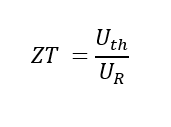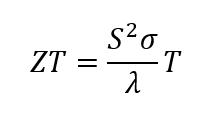Harman method
Direct measurement of the figure of merit ZT using the Harman method
The thermoelectric figure of merit ZT can either be calculated from the results of the individual measurements of the Electrical Conductivity, Seebeck Coefficient and Thermal Conductivity or measured directly. A common method for direct determination is the Harman method.
For the measurement, a thermoelectric sample in the form of a cylinder or rod is electrically contacted on the two end faces and with two contacts on one of the side faces (see picture below).

a) Schematic setup for direct ZT measurement of thermoelectric materials using the Harman method.
b) Measuring curve of a Harman measurement with ohmic voltage drop UR and occurring thermal voltage Uth with applied measuring current I.
For measurement accuracy, it is crucial to create adiabatic conditions as good as possible, i.e. to minimize the heat exchange between the sample and the environment.
For this reason, the measurement usually takes place under vacuum conditions and the sample is either stored free-standing or is fixed on a thermostatic controlled base plate.
In addition, a heat shield is usually used to reduce the heat exchange by radiation between the sample and the environment.
The measurement is started by impressing a current I0 between the contacts on the end faces, whereby one transition between sample and electrode is heated and the other is cooled due to the Peltier effect. The adiabatic boundary conditions subsequently result in a temperature gradient along the sample, where the magnitude of which depends on the impressed current and the thermoelectric properties of the sample. The voltage probes on the side surface of the sample are used to measure both, the ohmic component of the voltage drop UR, due to the impressed current, and the occurring thermal voltage Uth as a result of the temperature gradient (see Fig. 1b).
The ohmic component is measured directly after the current is applied, whereas the thermal voltage is determined in the stationary final state. ZT can be determined directly from the ratio of the two voltages.

The accuracy of the measurement method strongly depends on compliance with the adiabatic measurement conditions and the contact resistance between the sample and the current electrodes. This limits the maximum operating temperature of measurement setup based on the Harman technique to a maximum operation temperature of 200°C to 300°C.
Which properties are evaluated?
The Harman method can be used to measure the thermoelectric figure of merit ZT directly. Because of this direct measurement, the error for ZT can be kept small under good experimental conditions, compared to the conventional way of calculating ZT from single measurements performed by an LSR-3 (LSR L31) and LFA machine, as for this the error bars of the single measurement accumulate.

From the same formula it can also be seen, that the thermal conductivity as a material properties can be calculated from a combined Harman and power factor measurement. This can be an easy and cost-efficient solution to measure the thermal transport properties of thermoelectric samples using a standard platform like the Linseis LSR-3.
